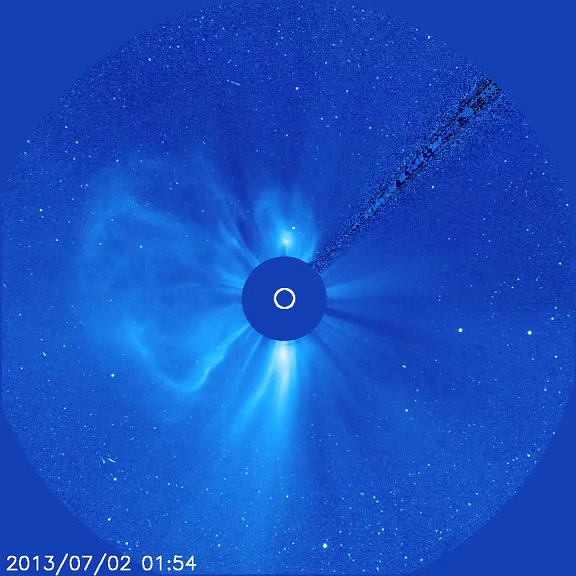

| Visitors Now: | |
| Total Visits: | |
| Total Stories: |

| Story Views | |
| Now: | |
| Last Hour: | |
| Last 24 Hours: | |
| Total: | |
NASA’s STEREO Spacecraft Witness a Coronal Mass Ejection & (ESA) Double Trouble Side By Side Solar Eruptions
Monday, July 22, 2013 9:37
% of readers think this story is Fact. Add your two cents.
On July 22, 2013, at 2:24 a.m. EDT, the sun erupted with a coronal mass ejection or CME, a solar phenomenon that can send billions of tons of solar particles into space that can affect electronic systems in satellites.
Experimental NASA research models based on observations from NASA’s Solar Terrestrial Relations Observatory, or STEREO, show that the CME was not Earth-directed, but may pass Mars.

NASA’s Solar Terrestrial Relations Observatory-Behind spacecraft, or STEREO-B, captured this image of a coronal mass ejection speeding away from the left side of the sun on July 22, 2013, at 3:09 a.m. EDT. The CME is traveling toward Mars. The bright light in the lower right is planet Mercury. – Image Credit: NASA/STEREO
It left the sun at around 715 miles per second, which is a fairly fast speed for CMEs. The CME may also pass by NASA’s STEREO-A spacecraft, and its mission operators have been notified.
If warranted, operators can put spacecraft into safe mode to protect the instruments from the solar material.
Image Credit: NASA/STEREO
NOAA’s Space Weather Prediction Center http://www.swpc.noaa.gov/ is the U.S. government’s official source for space weather forecasts, alerts, watches and warnings.
Updates will be provided if needed.
Karen C. Fox
NASA’s Goddard Space Flight Center, Greenbelt, Md.
Read more here:
DOUBLE TROUBLE
SIDE BY SIDE SOLAR ERUPTIONS
22 July 2013
Two solar eruptions expand side-by-side into space in this movie, playing out in front of the ESA/NASA Solar and Heliospheric Observatory, SOHO, on 1–2 July 2013.
The eruptions were coronal mass ejections, or CMEs, huge clouds of magnetised plasma ejected from the Sun’s atmosphere – the corona – and launched into interplanetary space.
CMEs comprise millions of tonnes of gas and race away from the Sun at several million kilometres per hour.

IMAGE: NASA/ESA
In the event shown in this movie, one small CME slowly emerges directly above the Sun as seen by SOHO. Shortly after, a much larger, faster event bursts from the left, and together the CMEs expand into space.
The larger event was likely triggered as a solar filament became unstable and lifted away from the Sun. Filaments form in magnetic loops and suspend cool, dense gas above the solar surface.
From above, filaments appear as dark lineaments against the hotter surface below, but in profile they form giant glowing loops called prominences. When their magnetic fields become unstable, they can trigger flares or CMEs.
WATCH THE VIDEO: Prominence Eruption at the Northeast of the Sun & Side by Side Solar Eruptions (CMEs)
Neither of these two CMEs interacted with Earth but when other events like these do, even a glancing blow to the planet’s magnetic field can ignite spectacular natural light displays – aurora – over the poles.
But in the most extreme events CMEs can cause much trouble, initiating geomagnetic storms that can result in regional power outages and communications blackouts.
The shaded disc at the centre of the image is a mask in SOHO’s LASCO instrument that blots out direct sunlight to allow study of the faint details in the Sun’s corona. The white circle added within the disc shows the size and position of the visible Sun.


